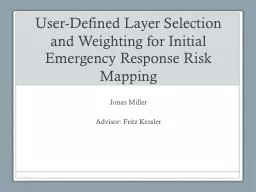

Jonas Miller Advisor Fritz Kessler Scenario Local emergency manager in Oso Washington is concerned with the risk of mudslide from week of sustained heavy rainfall How can local emergency managers leverage their experienceexpertise ID: 777348
Download The PPT/PDF document "User-Defined Layer Selection and Weighti..." is the property of its rightful owner. Permission is granted to download and print the materials on this web site for personal, non-commercial use only, and to display it on your personal computer provided you do not modify the materials and that you retain all copyright notices contained in the materials. By downloading content from our website, you accept the terms of this agreement.
Slide1
User-Defined Layer Selection and Weighting for Initial Emergency Response Risk Mapping
Jonas Miller
Advisor: Fritz Kessler
Slide2Scenario
Local emergency manager in
Oso
, Washington
is concerned
with the risk of mudslide from week of sustained heavy
rainfall.
How can local emergency managers leverage their experience/expertise
and
GIS to create a initial response risk map
?
How can this emergency manager identify areas with the greatest consequences of resource (natural, infrastructure, personnel) loss?
Slide32014 Oso, Washington Mudslide
Managers could quickly
assess the risks
of a mudslide
by overlaying relevant layers:
Topography – if a landslide occurs where will it be worst?Soil type – after heavy rain, where will a landslide occur?Population – who will a landslide affect?
Associated Press
Slide4Objective
Create a
simple
risk analysis mapping
tool in ArcGIS DesktopIntended use by local initial emergency responders and managers Include a customizable selection of data layers (publically available) Apply overlay weights that is based on subject knowledge / experience
Slide5Project Methodology
Identify the need for a initial emergency response mapping tool
Review previous applicable studies
Describe a target user
Assess target user’s needs/capabilities
Determine available, accessible, and free dataDevelop model Test modelValidate model
Slide6Risk Defined
Risk = consequences of expected losses
Previous studies of risk mapping:
Defined risk in the form of susceptibility mapped for single hazards:
Landslides, pipeline oil spills, tropical storm impact
Maps created using overlays of multiple features related to hazardGeomorphology, Population Density, Soil Characteristics, Hydrology
Slide7Previous Studies
Jafari
(2010): Iranian Pipeline study incorporating complex, multifactor environmental risk
factor
Poompavai
(2012): Indian Cyclone study introducing population-specific risk factors (‘coping’) with equally weighted categories
Slide8Previous StudiesAlexander (2010): UK study of
a emergency
r
esponse
m
apping tool with end-user input and feedbackAhmed (2015): User generated weighting of factors for Bangladeshi Landslides; concluded complete model requires input from both local officials and academic subject matter expertise
Slide9Target End UserLocal emergency manager with basic understanding of GIS and
expertise and experience
in emergency/disaster response
Timeframe: within first few (up to 12) hours of a response, before state/federal resources arrive
Scope: local
geographic levelMunicipality, County
Slide10Publically Available Emergency Management Data
ArcGIS Open Data: 56,470
datasets
ranging from local to national
s
caleDept of Homeland Security (DHS): Homeland Infrastructure Foundation Level Data (HIFLD) Open: 267 DHS supported datasets on national scale
Slide11Creating a Risk Index
Select data from publically available layers (HIFLD or ArcGIS Open Data)
Convert to raster: Feature to Raster or Euclidian Distance (for distance based risks) Tools
Apply Reclassify Tool to achieve same scale (0-9 based on suggested ArcGIS Help/ESRI Public Safety Team workflow)
Combine reclassified layers with Weighted Overlay Tool for Final Risk Index
Slide12ArcGIS Workflow
Slide13Example: Colorado Wildfire
Layers:
USA Urban Areas (HIFLD)
Fish and Wildlife Service Critical Habitat (ArcGIS Open Data)
Historical Fire
Perimeters (HIFLD)Weights w = 0.3 – Urban Areas (Population) Layerw = 0.2 – Historical Fire Layerw = 0.5 – Critical Habitat Layer
Slide14Douglas County, CO Wildfire Initial Response Risk Map
Slide15Limitations
End user requires baseline understanding of GIS
Subjective selection of layers and weights
How the layers are combined
Type of feature (polygons/lines only)
Scale of model (work with local datasets)
Slide16Future Plans
GEOG 596B Timeline
Fully
automate model
User
testing Validate with historical disaster/incident data Make tool available as Web Hosted Geoprocessing Tool on ArcGIS Online (in partnership w/ESRI Public Safety Team)Tentative Conference Presentations:Tugis – University of Towson, March 2017
PA GIS Conference, May 2017
Slide17References
Abuzied
, S., Yuan, M., Ibrahim, S., et al.
Journal of Arid Environments
(2016) 133: doi:10.1016/j.jaridenv.2016.06.004
Aubrecht, C., Özceylan, D., Steinnocher, K. et al. Natural Hazards (2013) 68: 147. doi:10.1007/s11069-012-0389-9. Environmental Systems Research Institute (ESRI), (2016). ArcGIS Desktop Help 10.4 Spatial Analyst.http://resources.arcgis.com/en/help/main/10.4/index.htmlJafari
, J., Khorasani, N., &
Danehkar
, A. (2010). Using environmental sensitivity index (ESI) to assess and manage environmental risks of pipelines in GIS environment: A case study of a near coastline and fragile ecosystem located pipeline.
World Academy of Science, Engineering and Technology
,
44
, 1101-1111.
Poompavai
, V. &
Ramalingam
, M. J Indian
Soc
iety
of Remote Sensing (2013) 41: 157. doi:10.1007/s12524-011-0198-8.
U.S. Department of Homeland Security, Federal Emergency Management Agency (2013).
National Response Framework
, pp. 2-13.
U.S. Department of Homeland Security, Homeland Infrastructure Foundation Level Data (2016). Geospatial Management Office. Available online at https://
hifld-dhs-gii.opendata.arcgis.com
/.
Special Acknowledgement to the ESRI Public Safety Team for consultation and guidance of the development of the ArcGIS Workflow
Slide18Questions?
Associated Press